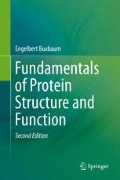Abstract
Enzyme and substrate form an ES-complex, which reacts further to enzyme and product. This process requires time, so each enzyme molecule can only handle a certain number of substrate molecules per unit time, called the turnover-number k cat. This number multiplied with the number of enzyme molecules is the limiting reaction velocity, V max, reached only at infinite substrate concentration. At [S] < ∞ enzyme molecules need time to find a new substrate after the release of product, hence v < V max.
Measuring the enzyme concentration in biological fluids is of great clinical significance.
Some enzymes are produced as inactive precursors and activated only when needed.
For some enzymes, the molecular mechanism of their action has been determined. If there are several substrates and/or products, substrates can bind to, and products be released from enzymes in specific order or randomly. Reaction mechanism is determined by keeping the concentration of one substrate constant, while varying the second. Different enzyme mechanisms result in characteristic Lineweaver-Burk-plots.
Access this chapter
Tax calculation will be finalised at checkout
Purchases are for personal use only
Notes
- 1.
Henri’s version of the HMM equation tries to take care of the increasing product concentration by treating the product as a competitive inhibitor of the reaction:
$$\displaystyle{ v = \frac{V _{\mathrm{max}}([S]_{0} - [P])} {1 + \frac{[S]_{0}-[P]} {K_{\mathrm{s}}} + \frac{[P]} {K_{p}}} }$$(5.28)with K s and K p the dissociation constants for substrate and product, respectively. [S]0 is the substrate concentration at the start of the experiment.
References
W.J. Albery, J.R. Knowles, Evolution of enzyme function and the development of catalytic efficiency. Biochemistry 15, 5631–5640 (1976). doi: 10.1021/bi00670a032
G.E. Briggs, J.B.S. Haldane, A note on the kinetics of enzyme action. Biochem. J. 19, 338–339 (1925)
W.W. Cleland, The kinetics of enzyme-catalyzed reactions with two or more substrates or products 1. Nomenclature and rate equations. Biochim. Biophys. Acta 67, 104–137 (1963). doi: 10.1016/0926-6569(63) 90211-6
R.G. Duggleby, Quantitative analysis of the time courses of enzyme-catalyzed reactions. Methods 24(2), 168–174 (2001). doi: 10. 1006/meth.2001.1177
R. Eisenthal, A. Cornish-Bowden, The direct linear plot. A new graphical procedure for estimating enzyme kinetic parameters. Biochem. J. 139(3), 715–720 (1974). URL http://www.biochemj.org/bj/139/0715/1390715.pdf
E. Fischer, Einfluss der Configuration auf die Wirkung der Enzyme. Ber. Dtsch. Chem. Ges. 27(3), 2985–2993 (1894). doi: 10.1002/cber. 18940270364
J.B.S. Haldane, Graphical methods in enzyme chemistry. Nature 179, 832 (1957). doi: 10.1038/179832b0
J.B.S. Haldane, K.G. Stern, Allgemeine Chemie der Enzyme (Steinkopf, Dresden, 1932)
V. Henri, Theorie generale de l’action de quelques diastases. Compt. rend. hebd. Acad. Sci. Paris 135, 916–919 (1902). URL http://gallica.bnf.fr/ark:/12148/bpt6k64607148/f1257.image
D.E. Koshland, Enzyme flexibility and enzyme action. J. Cell. Comp. Physiol. 54(Suppl. 1), 245 (1959). doi: 10.1002/jcp.1030540420
H.J. Lee, I.B. Wilson, Enzymic parameters: Measurement of V and Km. Biochim. Biophys. Acta 242(3), 519–522 (1971)
D.W. Marquardt, An algorithm for least-squares estimation of nonlinear parameters. J. Soc. Ind. Appl. Math. 11(2), 431–441 (1963). URL http://137.204.42.130/~bittelli/materiale_lettura_fisica_terreno/marquardt_63.pdf
L. Michaelis, M.L. Menten, Die Kinetik der Invertin-Wirkung. Biochem. Z. 49, 333–369 (1913). URL http://path.upmc.edu/divisions/chp/PDF/Michaelis-Menten_Kinetik.pdf
J.A. Nelder, R. Mead, A simplex method for function minimization. Comput. J. 7(4), 308–313 (1965). doi: 10.1093/comjnl/7.4.308
J.E. Nielsen, J.A. McCammon, Calculating pKa values in enzyme active sites. Protein Sci. 12, 1894–1901 (2003). doi: 10.1110/ps.03114903
B.A. Orsi, K.F. Tipton, Kinetic analysis of progress curves. Meth. Enzymol. 63, 159–183 (1979). doi: 10.1016/0076-6879(79)63010-0
O. Warburg, W. Christian, Pyridin, der wasserstoffübertragende Bestandteil von Gährungsfermenten. Biochem. Z. 287, 291–328 (1936). doi: 10.1002/hlca.193601901199
Author information
Authors and Affiliations
Rights and permissions
Copyright information
© 2015 Springer International Publishing Switzerland
About this chapter
Cite this chapter
Buxbaum, E. (2015). Enzyme Kinetics and Mechanism. In: Fundamentals of Protein Structure and Function. Springer, Cham. https://doi.org/10.1007/978-3-319-19920-7_5
Download citation
DOI: https://doi.org/10.1007/978-3-319-19920-7_5
Publisher Name: Springer, Cham
Print ISBN: 978-3-319-19919-1
Online ISBN: 978-3-319-19920-7
eBook Packages: Biomedical and Life SciencesBiomedical and Life Sciences (R0)

